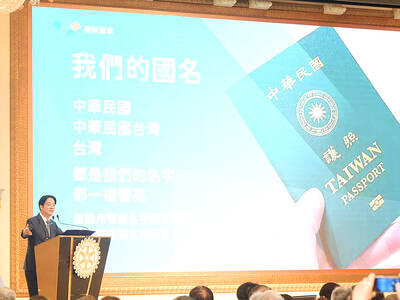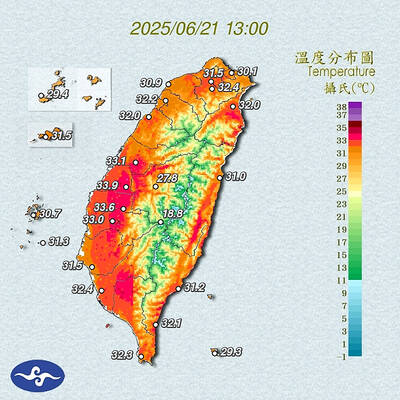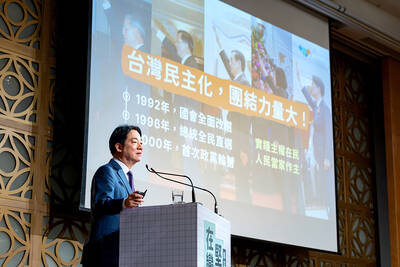Though the nation's military denies it's developing a cruise missile or a medium-range ballistic missile, defense analysts say there's evidence such programs exist.
The military has made the denials, they said, to avoid creating controversy in the international community.
Media reports have said the military is developing a cruise missile code-named Hsiung Feng-IIE, a variant of the domestically built Hsiung Feng-II anti-ship missile.
The Ministry of National Defense has strongly denied that the Hsiung Feng-IIE is a cruise missile, saying it is merely an enhanced version of the Hsiung Feng-II missile.
But Erich Shih (
"The Hsiung Feng-IIE is not the only cruise missile being developed by the Chung Shan Institute of Science and Technology," Shih said. "The Hsiung Feng-III missile under development at Chung Shan also has the potential to become a cruise missile."
Chung Shan has said that the Hsiung Feng-III is a super-sonic anti-ship missile, comparable to the Sunburn, a Russian-made equivalent that China has acquired.
"The Hsiung Feng-III is reported to have a range between 500km and 600km. With such a range, the missile surely has the potential to become a cruise missile in the future," Shih said.
Despite the missile's long range, the institute insists that the Hsiung Feng-III, like the Hsiung Feng-IIE, won't be a cruise missile as it is designed to be the navy's next-generation anti-ship missile.
But a defense source, who spoke on condition of anonymity, told the Taipei Times that the military may be keeping quiet in an attempt to quell any potential controversy in the international community that could result if word got out Taiwan was developing cruise missiles.
"The missile is apparently being developed under technical assistance from the US. A prototype of the missile had been test-fired several years ago in the US. If the US is not involved in the Hsiung Feng-IIE development program, how was Taiwan able to test-fire its missile in the US?" the source said.
The Hsiung Feng-IIE missile reportedly has a maximum range of 1,000km, capable of reaching military targets in China such as Guangzhou in the south as well as Shenyang in the north.
The missile development program, code-named "Hsiung Sheng," has been progressing for several years.
In addition, President Chen Shui-bian (
The Hsiung Feng-IIE is reportedly a copycat of the US-made Tomahawk.
Although the Hsiung Feng-IIE is designed as an offensive weapon, the military doesn't plan to use it for a first strike against China, Taiwan's enemy. Rather, the military plans to use the missile as a part of a counter-strike should China attack Taiwan.
Besides the Hsiung Feng-IIE, the military also denies that it is developing a medium-range ballistic missile code-named "Dichin."
A Chinese-language media report last month said the Dichin project has been proceeding for some time, with several test-firings of a prototype.
A defense official, who refused to be identified, told the Taipei Times that the medium-range ballistic missile has been in existence for many years, though the project isn't called "Dichin."
"We must pay attention to what the defense ministry has said about the medium-range ballistic missile report," the official said.
"The ministry only denies that the military is developing a missile project called `Dichin.' It hasn't denied that there is a medium-range ballistic missile project in existence in the military," the official said.
"The medium-range ballistic missile is likely an extension of the Sky Horse project in the 1970s, also a medium-range ballistic missile development project. Though the Sky Horse was cancelled due to pressure from the US, the medium-range ballistic missile project has never really stopped," he said.
The Sky Horse project, though officially terminated in 1982, has reportedly had some success, with around eight to ten missiles successfully being produced before the whole program stopped.
The missile is said to have a maximum range of 1,000km.
The Sky Horse project was a continuation of a short-range ballistic missile project code-named "Green Bee."
The Green Bee development project, which began in 1975, was called a success by Chung Shan in 1980 after a prototype of the short range ballistic missile had been successfully test-fired seven times.
But whether the military has deployed any of the Green Bee or Sky Horse missiles remains a mystery.

FREEDOM OF NAVIGATION: The UK would continue to reinforce ties with Taiwan ‘in a wide range of areas’ as a part of a ‘strong unofficial relationship,’ a paper said The UK plans to conduct more freedom of navigation operations in the Taiwan Strait and the South China Sea, British Secretary of State for Foreign, Commonwealth and Development Affairs David Lammy told the British House of Commons on Tuesday. British Member of Parliament Desmond Swayne said that the Royal Navy’s HMS Spey had passed through the Taiwan Strait “in pursuit of vital international freedom of navigation in the South China Sea.” Swayne asked Lammy whether he agreed that it was “proper and lawful” to do so, and if the UK would continue to carry out similar operations. Lammy replied “yes” to both questions. The

‘OF COURSE A COUNTRY’: The president outlined that Taiwan has all the necessary features of a nation, including citizens, land, government and sovereignty President William Lai (賴清德) discussed the meaning of “nation” during a speech in New Taipei City last night, emphasizing that Taiwan is a country as he condemned China’s misinterpretation of UN Resolution 2758. The speech was the first in a series of 10 that Lai is scheduled to give across Taiwan. It is the responsibility of Taiwanese citizens to stand united to defend their national sovereignty, democracy, liberty, way of life and the future of the next generation, Lai said. This is the most important legacy the people of this era could pass on to future generations, he said. Lai went on to discuss

AMENDMENT: Climate change is expected to increase the frequency of high-temperature days, affecting economic productivity and public health, experts said The Central Weather Administration (CWA) is considering amending the Meteorological Act (氣象法) to classify “high temperatures” as “hazardous weather,” providing a legal basis for work or school closures due to extreme heat. CWA Administrator Lu Kuo-chen (呂國臣) yesterday said the agency plans to submit the proposed amendments to the Executive Yuan for review in the fourth quarter this year. The CWA has been monitoring high-temperature trends for an extended period, and the agency contributes scientific data to the recently established High Temperature Response Alliance led by the Ministry of Environment, Lu said. The data include temperature, humidity, radiation intensity and ambient wind,

SECOND SPEECH: All political parties should work together to defend democracy, protect Taiwan and resist the CCP, despite their differences, the president said President William Lai (賴清德) yesterday discussed how pro-Taiwan and pro-Republic of China (ROC) groups can agree to maintain solidarity on the issue of protecting Taiwan and resisting the Chinese Communist Party (CCP). The talk, delivered last night at Taoyuan’s Hakka Youth Association, was the second in a series of 10 that Lai is scheduled to give across Taiwan. Citing Taiwanese democracy pioneer Chiang Wei-shui’s (蔣渭水) slogan that solidarity brings strength, Lai said it was a call for political parties to find consensus amid disagreements on behalf of bettering the nation. All political parties should work together to defend democracy, protect Taiwan and resist